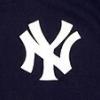Eddie Cicotte
Though he didn’t invent the pitch, Eddie “Knuckles” Cicotte was perhaps the first major-league pitcher to master the knuckleball. According to one description, Cicotte gripped the knuckler by holding the ball “on the three fingers of a closed hand, with his thumb and forefinger to guide it, throwing it with an overhand motion, and sending it from his hand as one would snap a whip. The ball acts like a ‘spitter,’ but is a new-fangled thing.”
Cicotte once estimated that 75 percent of the pitches he threw were knuckleballs. The rest of the time the right-hander relied on a fadeaway, slider, screwball, spitter, emery ball, shine ball, and a pitch he called the “sailor,” a rising fastball that “would sail much in the same manner of a flat stone thrown by a small boy.” Whether he was sailing or sinking the ball, shining it or darkening it, the 5-foot-9, 175-pound Cicotte had more pitches than a traveling salesman. “Perhaps no pitcher in the world has such a varied assortment of wares in his repertory as Cicotte,” The Sporting News observed in 1918. “He throws with effect practically every kind of ball known to pitching science.”
But the most famous pitch Cicotte ever threw was the one that nailed Cincinnati Reds leadoff man Morrie Rath squarely in the back to lead off the 1919 World Series, a pitch that signaled to the gamblers that the fix was on. After confessing to his role in the scandal one year later, Cicotte was banned from the game for life, a punishment that perhaps denied the 209-game-winner a spot in the Hall of Fame.
Cicotte began his baseball career, according to some sources, as early as 1903, playing semipro ball in the Upper Peninsula of Michigan. In 1904 he pitched for Calumet (Michigan) and Sault Ste. Marie (Ontario) in the Northern Copper League, posting a record of 38-4 with 11 shutouts.5 Based on that dominating performance, Cicotte earned a tryout with the Detroit Tigers in the spring of 1905. The Tigers determined that he wasn’t ready for the majors, and optioned him to Augusta (Georgia) of the South Atlantic League, where he compiled a record of 15 wins against 9 losses, and brawled with his young teammate Ty Cobb after a Cobb stunt cost Cicotte a shutout. As a joke Cobb had taken popcorn with him to his position in center field and as a result committed an error that led to a run. This incident notwithstanding, among his teammates Cicotte was known as an easygoing prankster who enjoyed a good laugh.
Near the end of the season Detroit brought Cicotte up and he made his major-league debut on September 3, 1905, allowing one run in relief and getting tagged with the loss in a 10-inning game. Two days later Cicotte earned his first major-league win, a complete-game victory over the Chicago White Sox. He finished the year 1-1 with a 3.50 ERA, but would not return to the major leagues for another three seasons.
The Boston Red Sox purchased Cicotte’s contract for $2,500 at the end of the 1907 season. During his five-year stint with the Red Sox, Cicotte lost nearly as many games as he won, and frequently found himself in trouble with Red Sox owner John I. Taylor, who accused the pitcher of underachieving. After Cicotte started the 1912 season with a 1-3 record and a 5.67 ERA in six starts, the Red Sox, though no longer owned by Taylor, had finally seen enough. On July 22 the team sold Cicotte’s contract to the Chicago White Sox, where the 28-year-old right-hander began to mature into one of the game’s best pitchers. With Boston, Cicotte had won 52 games and lost 46. Over the next 8½ seasons with the White Sox, he won 156 games against 101 losses.
The biggest reason for this improvement was Cicotte’s gradual mastery of his expansive pitching repertoire. As his command over his knuckleball improved, Cicotte’s walk rate dramatically decreased; from 1912 to 1920 he ranked among the league’s 10 best in fewest walks per nine innings seven times, leading the league in 1918 and 1919, when he walked 89 in 572⅔ innings.
Cicotte also fully exploited the era’s liberal regulations regarding the doctoring of the ball. In this area, his most infamous pitch was the shine ball, in which he rubbed one side of the ball against the pocket of his right trouser leg, which had been filled with talcum powder.
Flustered opponents protested to American League President Ban Johnson that the pitch should be outlawed, but Johnson ruled the pitch legal in 1917, and it would remain so until February 1920. Thanks to the knuckleball, the shine ball, the emery ball (ruled illegal by Johnson in early 1915), and other trick pitches, Cicotte struck out a fair number of batters, placing in the top 10 in strikeouts per nine innings three times, even though his fastball probably couldn’t break a plane of glass. Asked to explain his success, Cicotte chalked it up to “head work,” adding, “It involves an ability to adapt pitching to certain conditions when they arise and perhaps use altogether different methods in the very next inning.”
In 1917 the White Sox captured their first pennant since 1906. Cicotte led the way, ranking first in the league in wins (28), ERA (1.53), and innings pitched (346⅔). Eddie also tossed seven shutouts, including a no-hitter against the St. Louis Browns on April 14, the first of six no-hitters pitched in the major leagues that season. In that year’s World Series, Cicotte contributed one win to Chicago’s six-game triumph over the New York Giants. He was, according to Grantland Rice, “the most feared pitcher of the series.”
After Cicotte’s breakthrough season, Comiskey offered his star pitcher a $5,000 contract, with a $2,000 signing bonus, making him one of the highest compensated pitchers in baseball. But Cicotte failed to produce an encore suitable to his dominant 1917 campaign, as he wrenched his ankle in early May, and limped his way through the season to a mediocre 2.77 ERA and 19 losses, tied for the most in the league. It was not a performance to inspire Comiskey to hand out a raise, and when the 1919 season began, financial troubles were weighing heavily on Cicotte. According to the 1920 Census, Cicotte was the head of household for a family of 12, including his wife, Rose; their three children; his wife’s parents; Eddie’s brother and wife; and a brother-in-law and his wife and child. To make room for his large family, Cicotte took out a $4,000 mortgage on a Michigan farm.
Cicotte regained his 1917 form, pitching the White Sox to their second pennant in three years. Once again, Eddie led the American League in victories (29) and innings pitched (306⅔, tied with Jim Shaw). His 29-7 record was good enough to lead the league in winning percentage (.806), and his 1.82 ERA ranked second. In early September, first baseman Chick Gandil and infielder Fred McMullin approached Cicotte about throwing the World Series. After thinking it over, Eddie agreed to the scheme, telling Gandil privately, “I would not do anything like that for less than $10,000.” Three days before the Series began, Cicotte demanded to have the money in hand before the team left for Cincinnati. That night, he found $10,000 under his pillow.
Contrary to conventional wisdom, Cicotte’s abysmal performance in the 1919 World Series was not a complete surprise to informed observers. Throughout September, reports surfaced that the overworked Cicotte was suffering from a sore shoulder. Prior to the first game of the Series, Christy Mathewson noted, Cicotte “has had less than a week [actually two days] to rest up for his first start. … And that may not prove to be enough. If he blows up for a single inning it may cost the White Sox the championship, for I think the first battle is going to have a very strong bearing on the outcome, especially if the Reds win it.”
With at least six of his other teammates in on the fix, Cicotte led the way in blowing the first game, surrendering seven hits and six runs in 3⅔ innings of work, and fueling Cincinnati’s winning rally by throwing slowly to second base on what should have been an inning-ending double-play ball. The performance was so bad that it generated renewed speculation that Cicotte was suffering from a “dead arm.”
Though Eddie had received his $10,000 before the start of the Series, many of his fellow conspirators had not received the money promised them by the gamblers, so before Cicotte’s third start, in Game Seven of the best-of-nine Series, the players decided to play the game to win. Accordingly, Cicotte put forth his best effort of the Series, allowing just one run on seven hits in a 4-1 Chicago victory. Lefty Williams threw the following game, however, giving Cincinnati the world championship. In the wake of Chicago’s defeat, Mathewson publicly tossed aside rumors that the Series had been fixed.
Despite the persistent rumors that swirled around the club that offseason, Cicotte re-signed with Chicago for 1920, and put forth another excellent season, posting a 21-10 record with a 3.26 ERA. That summer Babe Ruth electrified the sport with his 54 home runs for the New York Yankees, but Cicotte grabbed a few headlines of his own after he stymied Ruth in several encounters. Asked to explain his success, the crafty Cicotte allowed that he mixed up his pitches and relied heavily on the spitball, because the pitch was “hard to hit for a long clout.”
On September 27, 1920, the Philadelphia North American ran a story in which Billy Maharg, one of the gamblers in on the Series fix the previous fall, testified to his role in the affair, and specifically named Cicotte as the man who initiated the plot. The next day, Eddie met with White Sox counsel Alfred Austrian and admitted to his role in the scandal. He also implicated seven of his teammates. Afterward, he went to the Cook County Courthouse and repeated his story for a grand jury charged with investigating corruption in baseball. The grand jury responded to Cicotte’s testimony by indicting all eight of the “Black Sox” players for throwing the 1919 World Series.
Though he and the other seven accused players were acquitted of conspiracy charges the following year, Eddie Cicotte’s major-league baseball career ended with his confession. For the next three years he played with several of his banned teammates for outlaw teams in Illinois, Wisconsin, and Minnesota, but by 1924 Cicotte had moved on with his life. He worked as a Michigan game warden and managed a service station before finding a job with the Ford Motor Company, where he remained until his retirement in 1944.
In an interview with Detroit sportswriter Joe Falls in 1965 he said he lived his life quietly, answering letters from youngsters who sometimes asked about the scandal. He agreed that he had made mistakes, but insisted that he had tried to make up for it by living as clean a life as he could. “I admit I did wrong,” he said, “but I’ve paid for it the past 45 years.” Falls seemed to agree, noting that as he prepared to leave Cicotte’s home, he looked at Eddie’s socks. They were white.



